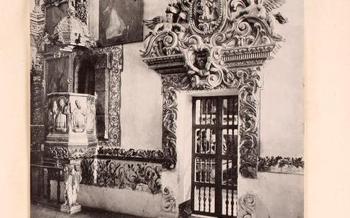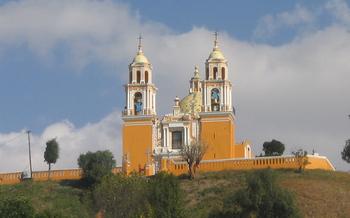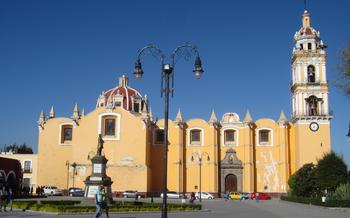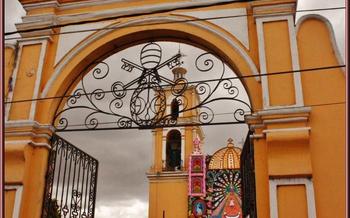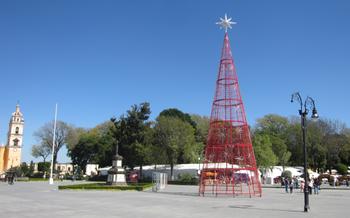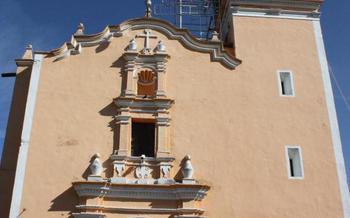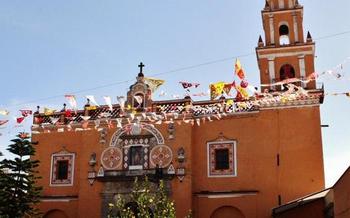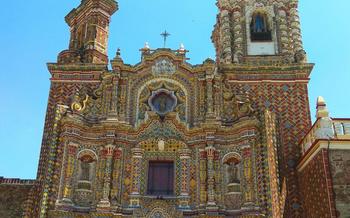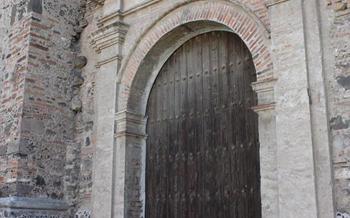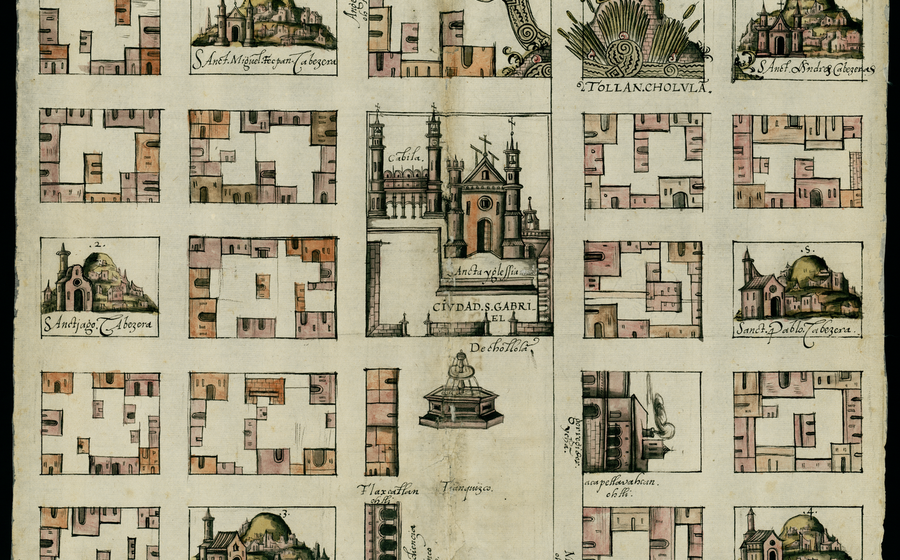
Cholula's Historical Archive
- History of the Cholula's Historical Archive
- Collections
- Architecture
- Exhibitions
- Educational Programs: Nurturing Curiosity and Knowledge
- Public Programs
- Community Engagement
- Preservation and Conservation
- Digitization and Access
- Staff and Volunteers
- Funding and Sustainability
- Collaboration and Partnerships
- Challenges and Opportunities
- Insider Tip:
History of the Cholula's Historical Archive
Founded in 1557, the Cholula's Historical Archive is one of the oldest and most significant archives in Mexico. Initially established as a repository for documents related to the city of Cholula and its surroundings, the archive has evolved over time to become a vital center for preserving and promoting the region's rich cultural heritage.
Throughout its history, the archive has served various functions. In the colonial period, it was primarily used by the Spanish colonial administration to manage land titles and other legal matters. After Mexico gained independence, the archive became a repository for historical documents related to the city's development and the surrounding region.
One of the most significant highlights in the archive's history was its designation as a UNESCO Memory of the World site in 20This prestigious recognition underscores the archive's importance as a repository of unique and irreplaceable documents that contribute to the world's cultural heritage.
The Cholula's Historical Archive continues to play a crucial role in preserving and promoting the region's cultural heritage. Through its extensive collection of documents, exhibitions, and educational programs, the archive provides researchers, students, and the general public with valuable insights into the history and culture of Cholula and the surrounding region.
Collections
The Cholula's Historical Archive houses a diverse array of materials that document the region's rich history and culture. These collections include:
-
Historical Documents: The archive contains a vast collection of historical documents, including manuscripts, letters, diaries, and account books. These documents provide valuable insights into the lives of the people who lived in the region, as well as the political, social, and economic developments that shaped its history.
-
Maps and Plans: The archive also houses a collection of maps and plans that depict the region's geography and development over time. These maps and plans are invaluable resources for researchers and historians studying the region's urban planning, land use, and transportation networks.
-
Photographs: The archive's collection of photographs documents the region's people, places, and events from the late 19th century to the present day. These photographs provide a visual record of the region's transformation over time and offer a glimpse into the daily lives of its residents.
-
Audiovisual Materials: The archive also holds a collection of audiovisual materials, including oral histories, films, and videos. These materials provide a unique and personal perspective on the region's history and culture.
The archive's collections are of great value to researchers, historians, and the general public. They provide a rich source of information for those studying the region's history, culture, and development. The archive also makes its collections accessible to the public through a variety of means, including online databases, exhibitions, and educational programs.
Architecture
The Cholula's Historical Archive is housed in a striking building that is a testament to the region's rich architectural heritage. Originally constructed in the late 16th century as a convent for the Franciscan order, the building showcases a blend of Renaissance and Gothic styles, creating a visually captivating structure. The facade of the building is adorned with intricate stone carvings, while the interior boasts a series of elegant arches and vaulted ceilings. Over the centuries, the building has undergone several renovations and additions, each contributing to its unique architectural character.
In the early 20th century, the building was adaptively reused to serve as the Cholula's Historical Archive. This transformation required careful consideration to preserve the building's historical integrity while adapting it to its new purpose. The architects and conservators worked meticulously to maintain the original architectural features while introducing modern elements that would facilitate the archive's operations. The result is a harmonious blend of old and new, creating a functional and inviting space for researchers, scholars, and visitors alike.
Exhibitions
The Cholula's Historical Archive organizes a variety of exhibitions to showcase its collections and engage with the public. These exhibitions can take various forms, from traditional displays of documents and artifacts to interactive multimedia presentations. The themes and topics explored in the exhibitions are diverse and cover a wide range of historical and cultural topics, including the history of Cholula, the region's indigenous cultures, and the role of the archive in preserving and promoting cultural heritage.
The process of curating and presenting the exhibitions involves careful research, selection of materials, and collaboration between archivists, historians, and designers. The goal is to create exhibitions that are both informative and engaging, providing visitors with a deeper understanding of the region's history and culture.
The exhibitions organized by the archive have a significant impact on the community and visitors. They attract a diverse audience, including local residents, tourists, students, and researchers. The exhibitions provide a platform for sharing knowledge and fostering dialogue about the region's rich history and cultural heritage. Through its exhibitions, the archive actively contributes to raising awareness and appreciation for the importance of preserving and promoting cultural heritage.
Educational Programs: Nurturing Curiosity and Knowledge
The Cholula's Historical Archive recognizes the importance of education in preserving and promoting cultural heritage. To this end, the archive offers a diverse range of educational programs tailored to engage and inspire learners of all ages.
These programs encompass workshops, lectures, and guided tours designed to delve into the archive's rich collections and explore various aspects of regional history and culture. Through interactive sessions and hands-on activities, participants gain insights into the significance of historical documents, the processes of archival preservation, and the methodologies of historical research.
The target audience for these educational programs is broad, encompassing students, teachers, researchers, and the general public. By catering to diverse audiences, the archive aims to foster a culture of appreciation for historical knowledge and encourage lifelong learning.
The goals and objectives of the educational programs are multifaceted. They seek to cultivate critical thinking skills, promote historical literacy, and instill a sense of respect for the past. By engaging with primary sources and delving into the stories they hold, participants gain a deeper understanding of the region's history and its relevance to contemporary society.
The impact of the educational programs extends beyond the classroom, contributing to the cultural vibrancy of the community. Through these programs, the archive plays a vital role in preserving and transmitting historical knowledge, fostering a sense of community pride, and inspiring future generations to become stewards of their cultural heritage.
Public Programs
The Cholula's Historical Archive organizes a variety of public programs to engage and educate the community. These programs are designed to make the archive's collections and resources accessible to a wide range of audiences.
One of the most popular public programs is the monthly "History Café." This informal gathering provides an opportunity for people to come together and discuss historical topics in a relaxed setting. The café features presentations by historians, authors, and other experts, followed by a lively Q&A session.
The archive also hosts regular workshops and classes on a variety of topics related to history and genealogy. These workshops are led by experienced professionals and are designed to provide participants with the skills and knowledge they need to conduct their own research.
In addition, the archive offers guided tours of its facilities. These tours provide visitors with an insider's look at the archive's collections and the work that goes on behind the scenes. Tours can be customized to meet the interests of specific groups, such as students, researchers, or history buffs.
The archive's public programs are free and open to the public. They are a great way to learn about the history of Cholula and the surrounding region, and to get involved with the archive's community.
Community Engagement
The Cholula's Historical Archive recognizes the importance of engaging with the local community to foster a sense of ownership and pride in the region's cultural heritage. To achieve this, the archive has implemented several initiatives and forged partnerships with local organizations.
One of the key initiatives is the "Living History" program, which invites community members to share their personal stories, memories, and anecdotes related to Cholula's history. These stories are then documented, preserved, and incorporated into the archive's collection, creating a rich tapestry of the community's collective memory.
The archive also collaborates with local schools and educational institutions to develop educational programs and workshops that focus on Cholula's history and culture. These programs aim to instill a sense of appreciation for the region's heritage among the younger generation and encourage them to become future stewards of the archive.
Furthermore, the archive actively participates in community events, festivals, and exhibitions, showcasing its collections and providing interactive experiences for visitors. These events serve as platforms for the archive to connect with the community, promote its services, and raise awareness about the importance of preserving cultural heritage.
Through these initiatives and partnerships, the Cholula's Historical Archive plays a vital role in fostering community engagement, promoting cultural identity, and ensuring that the region's rich history continues to be celebrated and cherished by future generations.
Preservation and Conservation
The Cholula's Historical Archive employs a comprehensive set of policies and procedures to ensure the preservation and conservation of its invaluable collections. These measures are meticulously implemented to safeguard the longevity and integrity of the historical documents entrusted to the archive's care.
The cornerstone of the archive's preservation strategy lies in the controlled storage of its collections. Documents are housed in specialized archival containers and stored in climate-controlled vaults, maintaining optimal temperature and humidity levels to prevent deterioration. Proper handling and access protocols further minimize the risk of damage to the delicate materials.
The archive also actively engages in preventive conservation practices to mitigate the effects of aging and environmental factors. Regular monitoring of the collections allows for the early detection and treatment of any potential issues, such as mold, insect infestation, or fading. The archive collaborates with experts in the field of conservation to implement appropriate restoration techniques when necessary.
Recognizing the importance of collective efforts in preserving cultural heritage, the archive fosters collaborations with other institutions and organizations. By sharing knowledge, resources, and expertise, the archive contributes to the advancement of preservation practices and the safeguarding of historical documents on a broader scale.
The archive's dedication to preservation and conservation ensures that its collections remain accessible to researchers, scholars, and the general public for generations to come. These efforts play a crucial role in preserving the region's cultural heritage and ensuring that the stories and experiences of the past are not lost to time.
Digitization and Access
The Cholula's Historical Archive is committed to preserving and promoting its collections through digitization. The archive has a dedicated team of professionals who are responsible for digitizing historical documents and making them accessible to the public online. The archive's digital collections include a wide range of materials, including manuscripts, photographs, maps, and newspapers. These materials are available to researchers, students, and the general public around the world.
The digitization of the archive's collections has had a profound impact on access. In the past, researchers had to visit the archive in person to view the materials. Now, they can access the materials from anywhere in the world with an internet connection. This has made the archive's collections more accessible to a wider range of people, including those who live in remote areas or who have disabilities.
The archive is also exploring new ways to use technology to make its collections more accessible. For example, the archive is working on a project to create a virtual reality tour of the archive building. This tour will allow visitors to explore the archive from anywhere in the world. The archive is also working on a project to create a mobile app that will allow visitors to access the archive's collections on their phones.
The digitization of the archive's collections is an ongoing process. The archive is working to digitize as many of its materials as possible so that they can be made accessible to the public. The digitization of the archive's collections is a valuable resource for researchers, students, and the general public. It is also a way to preserve and promote the region's cultural heritage.
Staff and Volunteers
The Cholula's Historical Archive is run by a dedicated team of professionals who are passionate about preserving and sharing the region's history. The staff includes archivists, historians, conservators, and educators who work together to ensure that the archive's collections are properly cared for, documented, and made accessible to the public. Volunteers also play a crucial role in the archive's operations, assisting with a variety of tasks such as digitizing documents, conducting research, and leading educational programs. The archive's staff and volunteers are committed to providing visitors with a welcoming and informative experience, and they are always happy to answer questions and share their knowledge about the archive and its collections.
Funding and Sustainability
The Cholula's Historical Archive relies on a variety of funding sources to support its operations and fulfill its mission of preserving and promoting the region's cultural heritage. These sources include government grants, private donations, and fundraising initiatives.
One of the major challenges faced by the archive is securing sustainable funding. Government grants and private donations can be unpredictable, and the archive must constantly work to diversify its funding streams.
Fundraising and grant-writing are essential activities for the archive to generate the necessary financial resources. The archive's staff and volunteers actively seek out grants from foundations and corporations, as well as organize fundraising events and campaigns.
The success of the archive's fundraising efforts is crucial for its long-term sustainability. With adequate funding, the archive can continue to acquire and preserve historical documents, develop and present exhibitions, offer educational programs, and engage with the community.
By supporting the Cholula's Historical Archive, donors and sponsors play a vital role in ensuring the preservation and promotion of the region's rich cultural heritage for future generations.
Collaboration and Partnerships
Collaboration and partnerships are essential for the success of the Cholula's Historical Archive. The archive collaborates with a variety of organizations and institutions, including universities, museums, libraries, and government agencies. These partnerships allow the archive to share resources, expertise, and knowledge, and to reach a wider audience.
For example, the archive has partnered with the National Autonomous University of Mexico (UNAM) to digitize and catalog its collection of historical documents. This partnership has made the archive's collections more accessible to researchers and the general public. The archive has also partnered with the Cholula City Council to develop educational programs and public events that promote the city's cultural heritage. These partnerships have helped the archive to increase its visibility and impact in the community.
Collaboration and partnerships are essential for the archive to fulfill its mission of preserving and promoting the region's cultural heritage. By working together with other organizations and institutions, the archive can achieve more than it could on its own.
Challenges and Opportunities
The Cholula's Historical Archive faces several challenges, including funding limitations and the preservation of aging documents. Securing sustainable funding is a constant struggle for the archive, as it relies on a combination of government grants, donations, and fundraising events to cover its operating expenses. The preservation of aging documents is another challenge, as the archive's collection includes many fragile and deteriorating items. The archive staff must constantly monitor the condition of the documents and take steps to prevent further damage.
Despite these challenges, the Cholula's Historical Archive also has several opportunities for growth and development. One opportunity is to expand its digital offerings. The archive is currently working on a project to digitize its entire collection, which will make it more accessible to researchers and the general public. Another opportunity is to increase community engagement. The archive is planning to offer more educational programs and public events to raise awareness of its collection and its mission.
The archive staff is working on several strategies to overcome challenges and capitalize on opportunities. To address the funding shortage, the archive is actively seeking grants and donations from individuals, foundations, and corporations. To preserve its aging documents, the archive is working with conservators to develop new techniques for preserving and repairing fragile materials. To expand its digital offerings, the archive is partnering with other institutions to develop a shared digital platform. To increase community engagement, the archive is working with local schools and community organizations to develop educational programs and public events.
The challenges and opportunities facing the Cholula's Historical Archive are significant, but the staff is confident that they can overcome them and continue to fulfill the archive's mission of preserving and promoting the region's cultural heritage.
Insider Tip:
A Hidden Treasure Trove of History:
Unveiling the secrets of the past, nestled amidst the cobblestone streets of Cholula, lies a hidden gem waiting to be discovered – the Cholula's Historical Archive. As you step through its unassuming entrance, prepare to be transported back in time as you delve into the rich tapestry of Cholula's history. This treasure trove of knowledge houses a vast collection of documents, photographs, and artifacts that paint a vivid picture of the region's past.
A Journey Through Time:
Begin your journey by exploring the archive's meticulously curated exhibitions. Immerse yourself in the stories of ancient civilizations, colonial rule, and the vibrant cultural traditions that have shaped Cholula's unique identity. Each exhibit is a testament to the enduring spirit of the Cholula people, showcasing their triumphs, struggles, and remarkable achievements.
Unveiling the Past, Preserving the Future:
The Cholula's Historical Archive serves as a vital link between the past, present, and future. Through its dedication to preserving and promoting the region's cultural heritage, the archive plays a crucial role in fostering a sense of community pride and identity. As you delve deeper into the archive's collections, you'll discover the profound impact that preserving our shared history has on shaping a better future for generations to come.
